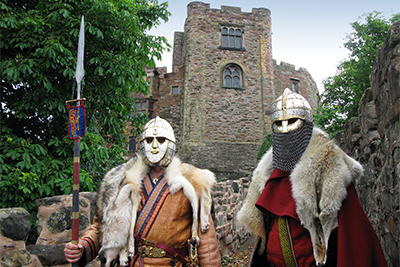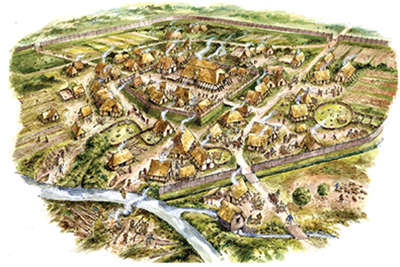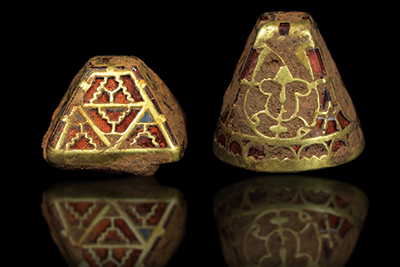Saxon Tamworth


Tamworth has a rich and fascinating history as the capital of the ancient Kingdom of Mercia and some of that heritage can still be seen and explored to this day.
The Anglo-Saxons came into Staffordshire in the late 6th century, as groups of settlers or tribes. The Mercians gradually conquered most of the other Midland tribes to become the most powerful Kingdom stretching from the Humber to the Thames. The three main powerful kingdoms were Mercia, Northumbria and Wessex.
Tamworth was the heartland of the Mercian Kingdom, which had a royal church at Repton, a religious centre at Lichfield and the King’s main residence at Tamworth. Certainly the Mercian Kings spent more time at Tamworth than anywhere else. There is believed to have been a royal palace at Tamworth by the end of the 7th century, on the site close to St. Editha’s Church. Originally it would have been a timber hall with chapel and somewhere for horses to be stabled. Evidence from signed charters shows that the Mercian Royal families stayed at Tamworth far more than their other palaces and were regularly here for festivals of Christmas and Easter between 751 and 857 A.D.
Tamworth is also known to have been important within Mercia, because it had a water mill which ground grain for food for the settlement and its livestock. The mill is believed to be the earliest (post Roman) watermill found in Britain. It was powered by the River Anker and used mill stones traded to King Offa from the French King Charlemagne, in exchange for English woollen cloaks. Mercian power began to decline after the death of King Offa and by the 10th century it lost its independence, becoming part of the Kingdom of Wessex to create the Kingdom of England.
There's much to explore about the town's Anglo Saxon heritage, including legends of the powerful Mercian warrior Aethelflaed, who is known to have re-fortified Tamworth in 913. The daughter of King Alfred the Great, she became known as the Lady of the Mercians. Her death in Tamworth in 918 resulted in Mercia being merged into Wessex. The iconic Aethelflaed Monument stands today at the foot of Tamworth Castle just through the Gatehouse. Download the Saxon Tamworth leaflet for more information.
|
Saxon Hoard

Today, Mercia continues to herald its importance with the discovery of the Staffordshire Hoard, the largest collection of Saxon gold ever found, unearthed not far from the Capital of Mercia. It has been dated from around 590 A.D to 750 A.D.
An exciting 'Battle & Tribute' exhibition featuring pieces from the Hoard helps visitors explore more about the power struggles of the Anglo-Saxon era, the battles, the blows and the bloodshed. This amazing craftsmanship is showcased at Tamworth Castle, along with artefacts that are brought to life with stunning replica weapons.
We may never know why it was buried or who it belonged to but it will hopefully, in time, unlock some of the secrets of the Saxon age and Anglo-Saxon Tamworth.
More information can be found on the Staffordshire Hoard website.
Saxon Facts
- Penda King of Mercia, warlike and the last Pagan English King. He died in battle against the Northumbrians who took control of Mercia.
- Wulfhere son of Penda and the first Christian King of Mercia.
- Aethelred son of Penda, succeeds his brother Wulfhere to the throne of Mercia.
- Offa as King of Mercia, became the most powerful of all rulers, also known as King of all the English. He erected a palace in Tamworth so magnificent in style and furnishings, that it was declared to be ‘the wonder of the age’. He fortified the town with a huge earthwork – a wall and a ditch – resting on the rivers Tame and Anker and encircling the town. Charters were granted by Offa from the palace at Tamworth. Offa spent Christmas at Tamworth in 781 AD. He had links with the famous King Charlemagne exchanging letters and gifts and established trading connections as far as Arabia. We will never know why he murdered so many of his relatives following his victory at the Battle of Seckington.
- Aethelflaed, the daughter of King Alfred the Great, has been described as ‘our greatest woman-general’, one of the most effective leaders we ever had, who commanded troops for eight years and ruled a country as well. She drove back the marauding Danes and seized Watling Street, a strategical highway as the southern boundary of the Danelagh (the border between the Danes and Anglo-Saxons). To strengthen her line of communication across England she established a chain of fortified posts, and in the early summer of 913 AD, with her Mercians, marched to Tamworth, and here, at the junction of its two rivers established a fortification. We know it today as Tamworth Castle. She became Queen of Mercia, although she never claimed to be queen for sound political and personal reasons and assumed the title ‘Lady of the Mercians’. She died at Tamworth on 12 June 920 AD, an event which resulted in Mercia being merged into Wessex.
- When Aethelflaed died her rule was passed to her daughter Ælfwynn, the first ever recorded female-to-female succession in Europe. However, it was a brief reign and only lasted about six months before her uncle Edward launched a coup d’état, depriving her of all authority and taking her into Wessex.
- Aethelstan nephew to Aethelflaed and also taught by her the arts of war and kingship, she taught him to read and gave him a jewelled dagger as a symbol of his rank. When he succeeded to the throne of Wessex, after the death of his father, Edward the Elder, he waged ceaseless war against the Danes and again made Tamworth a royal seat. Aethelstan was one of the greatest warriors, administrators and patrons of art to occupy the English throne in the early medieval period. Aethelstan became King of all England by clinching victory at the battle of Brunanburh. He died in 943AD.
- Editha, sister of Aethelstan, married Danish leader Sihtric in 925AD. Sihtric broke his Christian vows and relapsed into paganism, deserting Editha. Sihtric died during battle and Editha retired into a convent which she founded at Tamworth, close to the palace where she had reigned as a bride.




 CELEBRATING ELEVEN HUNDRED YEARS – Athelstan
CELEBRATING ELEVEN HUNDRED YEARS – Athelstan
